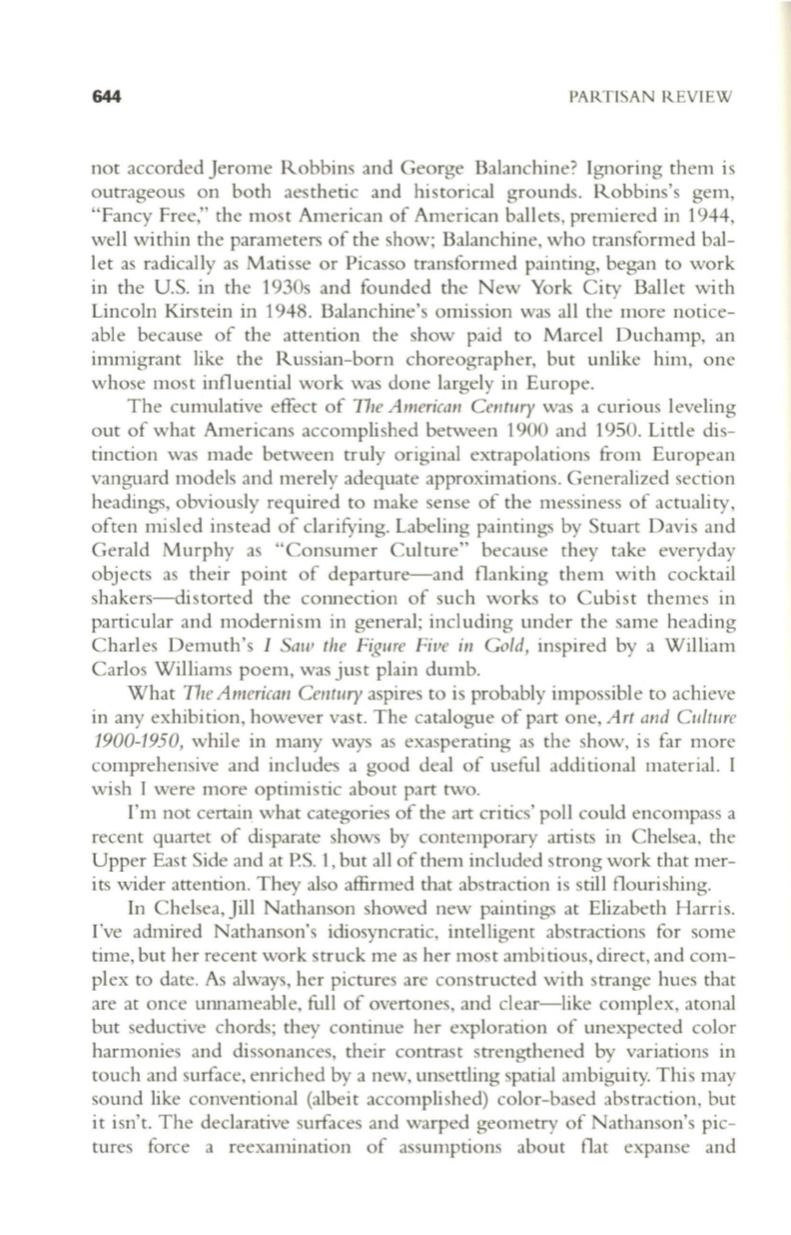
644
PARTISAN REVIEW
not accorded Jerome Robbins and George Balanchine? Ignoring them is
outrageous on both aesthetic and historical grounds. Robbins's gem,
"Fancy Free," the most American of American ballets, premiered in 1944,
well within the parameters of the show; Balanchine, who transformed bal–
let as radically as Matisse or Picasso transformed painting, began to work
in the U.S. in the 1930s and founded the New York City Ballet with
Lincoln Kirstein in 1948. Balanchine's omission was all the more notice–
able because of the attention the show paid to Marcel Duchamp, an
immigrant like the Russian-born choreographer, but unlike him, one
whose most influential work was done largely in Europe.
The cumulative effect of
The American Century
was a curious leveling
out of what Americans accomplished between 1900 and 1950. Li ttle dis–
tinction was made between truly original extrapolations from European
vanguard models and merely adequate approximations. Generalized section
headings, obviously required to make sense of the messiness of actuality,
often misled instead of clarifying. Labeling paintings by Stuart Davis and
Gerald Murphy as "Consumer Culture" because they take everyday
objects as their point of departure-and flanking them with cocktail
shakers-distorted the connection of such works to Cubist themes in
particular and modernism in general; including under the same heading
Charles Demuth's
I Saw the Figure Five in Cold,
inspired by a William
Carlos Williams poem, was just plain dumb.
What
The American Celltury
aspires to is probably impossible to achieve
in any exhibition, however vast. The catalogue of part one,
Art and Culture
1900-1950,
while in many ways as exasperating as the show, is far more
comprehensive and incl udes a good deal of useful addi tional material. I
wish I were more optimistic about part two.
I'm not certain what categories of the art critics' poll could encompass a
recent quartet of disparate shows by contemporary artists in Chelsea, the
Upper East Side and at P.S. 1, but all of them included strong work that mer–
its wider attention. They also affirmed that abstraction is still flourishing.
In Chelsea, Jill Nathanson showed new paintings at Ebzabeth Harris.
I've admired Nathanson's idiosyncratic, intelbgent abstractions for some
time, but her recent work struck me as her most ambi tious, direct, and com–
plex to date. As always, her pictures are constructed with strange hues that
are at once unnameable, full of overtones, and clear-like complex, atonal
but seductive chords; they continue her exploration of unexpected color
harmonies and dissonances, their contrast strengthened by variations in
touch and surface, enriched by a new, unsettling spatial ambiguity. This may
sound like conventional (albeit accomplished) color-based abstraction, but
it isn't. The declarative surfaces and warped geometry of Nathanson's pic–
tures force a reexamination of assumptions about flat expanse and


